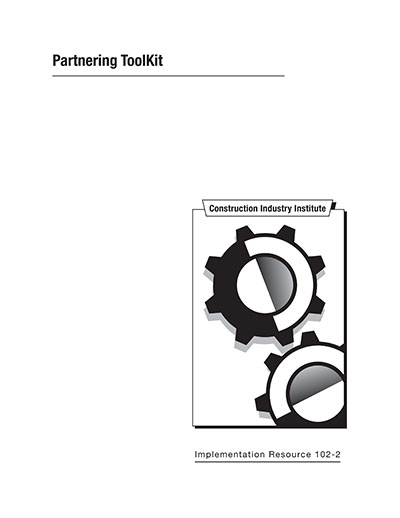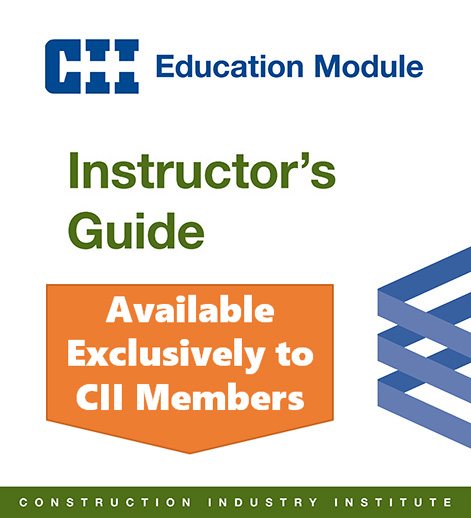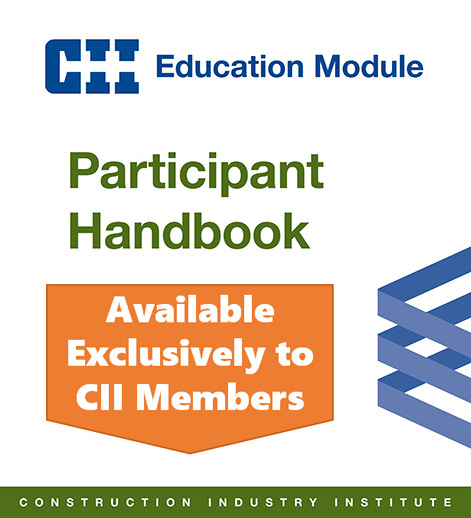
Partnering ToolKit
Partnering is a proactive management process that integrates and optimizes the value-added services of each party to best achieve the business objectives of all parties within the relationship. Partnering is often referred to as the return to the use of common values and honorable business practices that once were key elements of society in general. Partnering utilizes the concepts of teamwork, trust, and honesty in order to promote the common goals of the partnering relationship (PR) and to develop a win-win mentality and atmosphere for all parties involved.
In 1987, the Construction Industry Institute (CII) organized a task force for the purpose of researching the feasibility of partnering in the construction industry. The first CII Partnering Task Force defined partnering as:
“...a long-term commitment between two or more organizations for the purpose of achieving specific business objectives by maximizing the effectiveness of each participant’s resources. This requires changing traditional relationships to a shared culture without regard to organizational boundaries. The relationship is based upon trust, dedication to common goals, and an understanding of each other’s individual expectations and values. Expected benefits include improved efficiency and cost effectiveness, increased opportunity for innovation, and the continuous improvement of quality products and services.”
The CII Partnering Task Force determined that partnering is beneficial to the construction industry. However, there was a lack of information and completed research pertaining to the implementation of successful PRs and the in-process management of PRs. Research to date had not identified the key steps needed to successfully implement and manage a partnering relationship. Research was needed to identify the key steps of implementing partnering on projects and the measurement system needed to support this effort. Therefore, in 1993, CII established the Partnering II Research Team to study the implementation and in-process management of PRs.
This research team had three objectives:
- To identify and develop a set of measures to assess the benefits of partnering.
- To determine partnering benchmarks for the construction industry.
- To identify key success factors and barriers to the partnering implementation process.
There are two distinct types of PRs in use: strategic alliances and project-specific partnering. Strategic alliances are long-term commitments between two or more organizations for the purpose of achieving specific business objectives by maximizing the effectiveness of each participant’s resources. Strategic alliances focuses on long-term goals of the relationship to obtain the maximum benefits. The second form, project specific partnering, is a commitment between two or more organizations for the purpose of achieving specific project objectives by maximizing the effectiveness of each participant’s contribution. (CII 17-1, 1991)
The concept of project specific partnering was first implemented in the construction industry in the mid-1980s to duplicate the successes that the manufacturing industry achieved through supplier partnering and business alliances. In the private sector, numerous industries have successfully used partnering to achieve project and business objectives. Government agencies such as the U.S. Army Corps of Engineers and the Arizona Department of Transportation have been at the forefront of the partnering movement in the public sector.
The Partnering II Research Team validated that partnering is not necessarily a “long-term commitment.” Project-specific partnering is a short-term commitment that is viable, extremely valuable, and is as effective on short duration projects as a strategic alliance is on long-term relationships.
Partnering ToolKit Purpose
The purpose of the Partnering ToolKit is to aid in evaluating partnering, preparing for partnering, selecting a partner, and implementing and maintaining a partnering relationship. It is an excellent start to record in a single document an assembly of concepts and practices found beneficial in a wide range of past partnering relationships as well as to offer additional methods arising from the collective findings and experience of other Partnering groups.
Several cautions in using the Partnering ToolKit are warranted. First, the “tools” must be applied with judgment. Each tool does not necessarily fit each circumstance exactly, hence careful tool selection and modification are needed. The Partnering ToolKit requires skilled and committed “craftsmen.” These individuals must overview the partnering implementation efforts to ensure the right tools are applied in the right sequence and obtain the right results.
Partnering continues to evolve, providing new experiences which many times remain undocumented. Capturing partnering tools used to adapt to, or overcome the effects of, changing market conditions, as well as the clashing of corporate cultures, will remain both a significant challenge and opportunity to develop the Partnering ToolKit to its full potential.
The tools presented in this Partnering ToolKit were provided by companies participating in project partnering and strategic alliances. They represent tools being used by these relationships in their everyday work. The research team has altered them only to delete company identification and, in some cases, to utilize nomenclature recognized by all industries. Tools are identified as being applicable to strategic alliances or project specific or applicable to both (common tools). Each Section contains a Checklist of Key Elements that should be considered in each phase. Your particular situation may necessitate more Key Elements—this listing is a minimum and may need expanding.
Partnering ToolKit Sections Summary
The following is a summary of each Partnering ToolKit Section:
- Section II – Partnering Process Model describes the five phase process incorporating executive, management, and craft level participants who will implement and manage the partnering process.
- Section III – Owner's Internal Alignment describes the owner’s process for identifying business drivers, evaluating partnering options, and internally preparing and aligning for partnering.
- Section IV – Partner Selection focuses on preparing the partner selection criteria, developing a request for proposal, developing contractual language, evaluating responses from potential partners, and identifying roles and responsibilities.
- Section V – Partnership Alignment describes the development of aligned objectives that support each partner’s strategic objectives, measures to successfully determine the accomplishment of the objectives, and methodology for rewarding successful alliance accomplishments.
- Section VI – Project Alignment describes developing aligned project objectives and implementing incentive and measurement plans that support these objectives.
- Section VII – Work Process Alignment establishes intra-project goals and work processes consistent with and in support of project objectives.
- Section VIII – Measures presents a variety of partner measurement criteria in the following categories: health and safety; environment; quality; accuracy; functionality; responsiveness; flexibility; planning; project administration; technology; cost control; schedule control; teamwork/partnership; constructability; and procurement.
Partnering ToolKit Computer File Formats and Instructions
Computer files are on the attached diskette so the user can modify the contents of this Partnering ToolKit for the specific needs of their partnering relationship. Computer files of the information contained in this Partnering ToolKit are presented in electronic format on the diskette enclosed in this packet. The computer files have been designated as read-only to preserve each file’s contents for reuse. Follow the instructions listed below to set up your system with the Partnering ToolKit computer files.
The purpose of the Partnering ToolKit is to aid in evaluating partnering, preparing for partnering, selecting a partner, and implementing and maintaining a partnering relationship. It is an excellent start to record in a single document an assembly of concepts and practices found beneficial in a wide range of past partnering relationships as well as to offer additional methods arising from the collective findings and experience of other Partnering groups.


